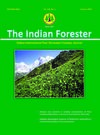Role of Endogenous Hormones in Gender Determination in Casuarina equisetifolia
DOI:
https://doi.org/10.36808/if/2018/v144i1/121303Keywords:
Phytohormones, Dioecious, Monoceious, Casuarina equisetifolia.Abstract
Endogenous levels of phytohormones like auxin, gibberellins, cytokinin, abscisic acid and ethylene appear to determine the fate of flower sex. In higher levels of auxins, cytokinins and ethylene have been found to be correlated with female sex expression whereas a greater amount of gibberellins favors the differentiation of male sex organs. There are three types of plants in regard to sexuality: those in which male and female flower are born on separate (dioecious), those that bear male and female flower on same plant (monoecious) and those in which male and female organs are born together in same plant. Three types of sexual patterns are exists (male, female and monoceious) in Casuarina equisetifolia. Hence we attempted to study the role of endogenous hormones such as auxins and gibberellins in Casuarina equisetifolia to determine its genders . This study was carried out to screen four types of clonal samples such as male, female, monoceious and inconstant. The results from the study revealed that higher levels of IAA have been found to be correlated with female sex expressions whereas a greater amount of gibberellins favors the differentiation of male sex organs. Phenotypic expression of flower sex is controlled by a balance between male and female promoting hormones.References
Atsmon D. (1968). The interaction of genetic environmental, and hormonal factors in stem elongation and floral development of cucumber plants.Annals of Botany, 32: 677-882.
Chailakhyan M.H. (1937). Hormone Theory of PlantDevelopment. Moscow-Leningrad, Acad. of Sci. USSR, 198 pp.
Duncan B.D. (1965). Multiple range and multiple test. Biometric, 11:1-42.
Flach M. (1966). Nutmeg cultivation and its sex problems. Eng. Sum. Meded. Landh Hogesh. 66, 1, Sri Lanka, 19:91-98.
Freeman D.C., Harper K.T. and Ostler K. (1980). Ecology of plant diocy in the intermountain region of western north America and California. Oecologia, 44: 410-417.
Gordon S.A. and Weber R.P. (1951). Colorimetric estimation of lndoleacetic acid. Plant Physiology, 26: 192-195.
Graham H.D. and Henderson J.H.M. (1961). Reaction of gibberellic acid and gibberellins with Folin-Wu, Phosphomolybdic acid reagent and its use for quantitative assay. Plant Physiology, 36: 405-408.
Hormaza J.I., Dolio L. and. Polito V.S. (1994). Identification of a RAPD marker linked to sex determination in Pistacia vera using bulked segregant analysis. Theoretical Applied Genetics, 89:9-13.
Kh ryani n V. N. (2002). Russian Journal of Plant Physiology, 49( 4): 545-551.
Mauseth J.D. (1991). Botany: An Introduction to Plant Biology. Philadelphia: Saunders, 348-415 pp.
Mulcahy D.L., Weeden N.F., Kesseli R. and Carroll S.(1992). DNA probe for Y-chromosome of Silene latifolia, a dioecious angiosperm. Sex Plant Reprod., 5:86-88.
Nayar B.K., Rajendar R. and Vathsala P. (1977). A simple morphological technique to distinguish the sex of nutmeg seedlings. Current Science, 46:156-157.
Packiyasothy E.V., Jansz E.R. and Dharmadasa H.M. (1991). Studies on some chemical components of nutmeg (Myristicafragrans Houtt.) leaf directed at determination of sex of seedlings. J. Natn. Sci. Coun. Sri Lanka, 19:91-98.
Peterson and Anhder L.D. (1960). Induction of staminate flowers on gynoecious cucumbers with gibberellins. Science, 131:1673-1674.
Phadnis N.A. and Choudhary K.G.(1971). Sex determination in the seedling stage of nutmeg (Myristica fragrans Houtt.). Tropical Science, 13:265-274.
Raven P.H., Evert R. F. and Eichhorn S.E. (1992). Biology of plants. 5th Ed, worth publishers, New York.
RichardsA.J. (1986). Plant Breeding Systems. Chapman and Hall, Madras. 527p.
Salisbury F.B. and Ross C.W. (1992). Plant Physiology, worth publishers, New York.
Srivastava L.M. (2002). Plant Growth and Development: Hormones and Environment. Amsterfam: Academic press.140 pp.
Sundberg E. and Ostergaard L. (2009). Distinct and dynamic auxin activities during reproductive development. Cold Spring Harbo perspectives In Biology, 1(6): a 001628.
Troup R.S. (1921). TheSilvicultureof Indian Trees. International Book Distributors, Dehradun, 3: 900-908.
Zachariah J., Gopalan A. Krishnamurthy B. and Ravindran P.N. (1986). Steroid degradation compound associated with sex expression in nutmeg (Myristicafragrans Houtt.). In Proceedings, Indian National Science Academy. 52:685-688.
Downloads
Downloads
Published
How to Cite
Issue
Section
License
Unless otherwise stated, copyright or similar rights in all materials presented on the site, including graphical images, are owned by Indian Forester.





